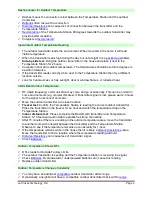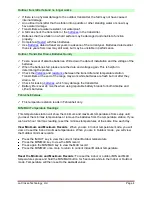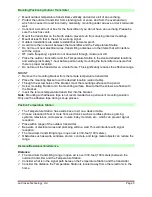
La Crosse Technology, Ltd.
Page 5
Mounting/Positioning Outdoor Transmitter
Mount outdoor temperature transmitters vertically and under a bit of an overhang.
Protect the outdoor transmitter from standing rain or snow, and from the overhead sun,
which can cause it to read incorrectly. Generally, mounting under an eave or deck rail works
well.
Construct a small roof or box for the transmitter if you do not have an overhang. Please be
sure the box has vents.
Mount the transmitter on the North side to prevent sun from causing incorrect readings.
Mount at least 6 feet in the air for a strong signal.
Outdoor transmitters are water resistant but not water proof.
Avoid more than one wall between the transmitter and the Temperature Station.
Do not mount near electrical wires, transmitting antennas or other items that will interfere
with the signal.
RF (radio frequency) signals do not travel well through moisture or dirt.
Place the outdoor transmitter and the Temperature Station in the desired shaded locations,
and wait approximately 1-hour before permanently mounting the transmitter to ensure that
there is proper reception.
Do not mount the transmitter on a metal fence. This significantly reduces the effective range.
MOUNT
Remove the mounting bracket from the remote temperature transmitter.
Place the mounting bracket over the desired location (wall or table).
Through the screw holes of the bracket, mark the mounting surface with a pencil.
Screw mounting bracket onto the mounting surface. Ensure that the screws are flush with
the bracket.
Insert the remote temperature transmitter into the bracket.
Note
: Mounting with adhesive tape is not recommended as a permanent mounting solution.
Only use the adhesive tape during set-up process.
Position Temperature Station
The Temperature Station has a wide base to sit on a desk or table.
Choose a location 6 feet or more from electronics such as cordless phones, gaming
systems, televisions, microwaves, routers, baby monitors, etc., which can prevent signal
reception.
Place within range of the outdoor transmitter.
Be aware of electrical wires and plumbing within a wall. This will interfere with signal
reception.
The maximum transmitting range in open air is 330-feet (100 meters).
Obstacles such as walls, windows, stucco, concrete, and large metal objects can reduce the
range.
Distance/Resistance/Interference
Distance:
The maximum transmitting range in open air is over 330-feet (100 meters) between the
outdoor transmitter and the Temperature Station.
Consider what is in the signal path between the Temperature Station and the transmitter.
Consider the distance the Temperature Station is located away from other electronic in the
home.

























